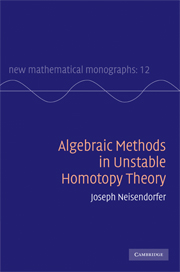Book contents
- Frontmatter
- Contents
- Preface
- Acknowledgments
- Introduction to unstable homotopy theory
- 1 Homotopy groups with coefficients
- 2 A general theory of localization
- 3 Fibre extensions of squares and the Peterson–Stein formula
- 4 Hilton–Hopf invariants and the EHP sequence
- 5 James–Hopf invariants and Toda–Hopf invariants
- 6 Samelson products
- 7 Bockstein spectral sequences
- 8 Lie algebras and universal enveloping algebras
- 9 Applications of graded Lie algebras
- 10 Differential homological algebra
- 11 Odd primary exponent theorems
- 12 Differential homological algebra of classifying spaces
- Bibliography
- Index
3 - Fibre extensions of squares and the Peterson–Stein formula
Published online by Cambridge University Press: 03 May 2010
- Frontmatter
- Contents
- Preface
- Acknowledgments
- Introduction to unstable homotopy theory
- 1 Homotopy groups with coefficients
- 2 A general theory of localization
- 3 Fibre extensions of squares and the Peterson–Stein formula
- 4 Hilton–Hopf invariants and the EHP sequence
- 5 James–Hopf invariants and Toda–Hopf invariants
- 6 Samelson products
- 7 Bockstein spectral sequences
- 8 Lie algebras and universal enveloping algebras
- 9 Applications of graded Lie algebras
- 10 Differential homological algebra
- 11 Odd primary exponent theorems
- 12 Differential homological algebra of classifying spaces
- Bibliography
- Index
Summary
In this chapter we discuss fibre extensions of squares, a notion which is dual to the cofibration squares which appear in Lemma 1.5.1 and which are used in the construction of the Bockstein long exact sequences for homotopy groups with coefficients. A fibre extension is formed by starting with a commutative square of maps, replacing the maps by fibrations, and extending the square to a larger square where all the rows and columns are fibration sequences.
Fibre extensions of squares are used in the study of homotopy pullbacks, for example, to prove the fracture lemmas for localization. The main result here is that the homotopy theoretic fibre of a map of homotopy pullbacks is itself a homotopy pullback. For this purpose we need to study the higher dimensional fibre extensions of cubes.
The treatment we give of fibre extensions of squares has the advantage that it is efficient and self contained. It has the disadvantage that it does not embed it as part of a larger theory of homotopy inverse limits, as it could be if we were willing to develop that theory here. In this more general context, the result concerning fibre extensions of squares would be a trivial consequence of the commutativity of homotopy inverse limits over a product category.
Fibre extensions of squares have appeared in the work of Cohen–Moore–Neisendorfer and also in the work of Goodwillie on analytic functors.
- Type
- Chapter
- Information
- Algebraic Methods in Unstable Homotopy Theory , pp. 94 - 106Publisher: Cambridge University PressPrint publication year: 2010



